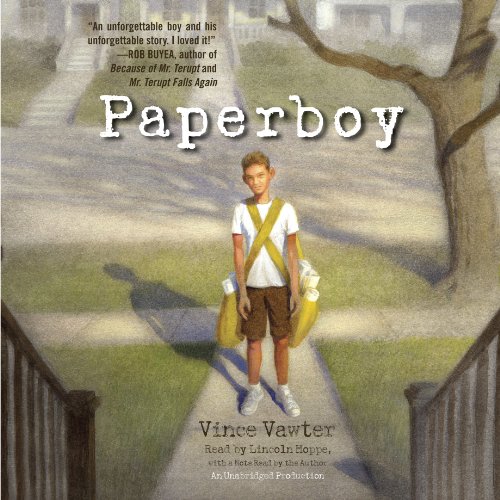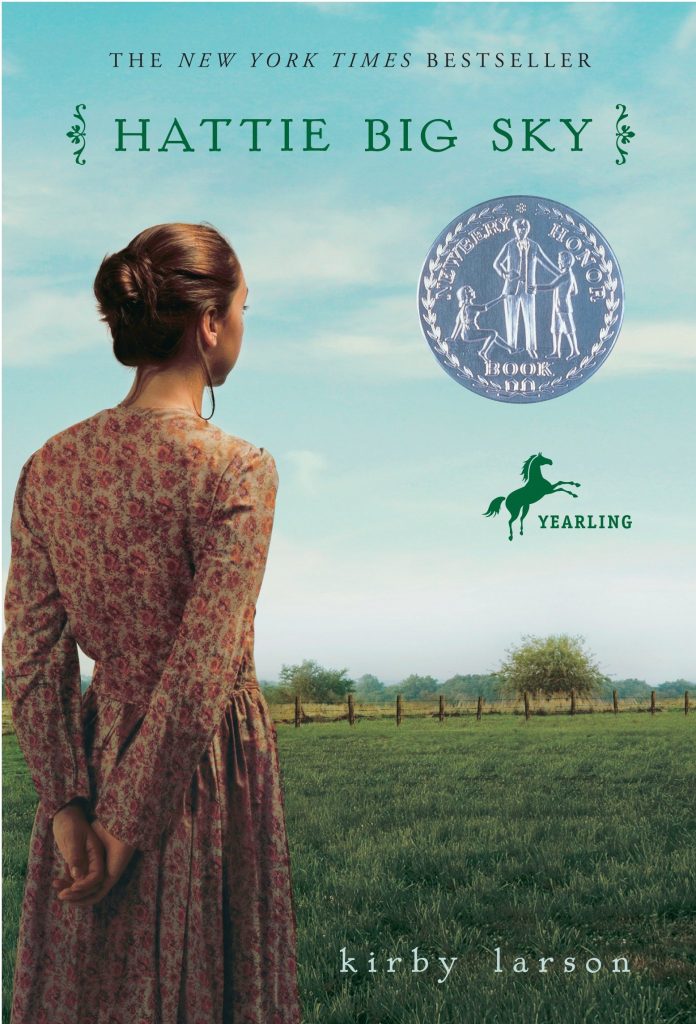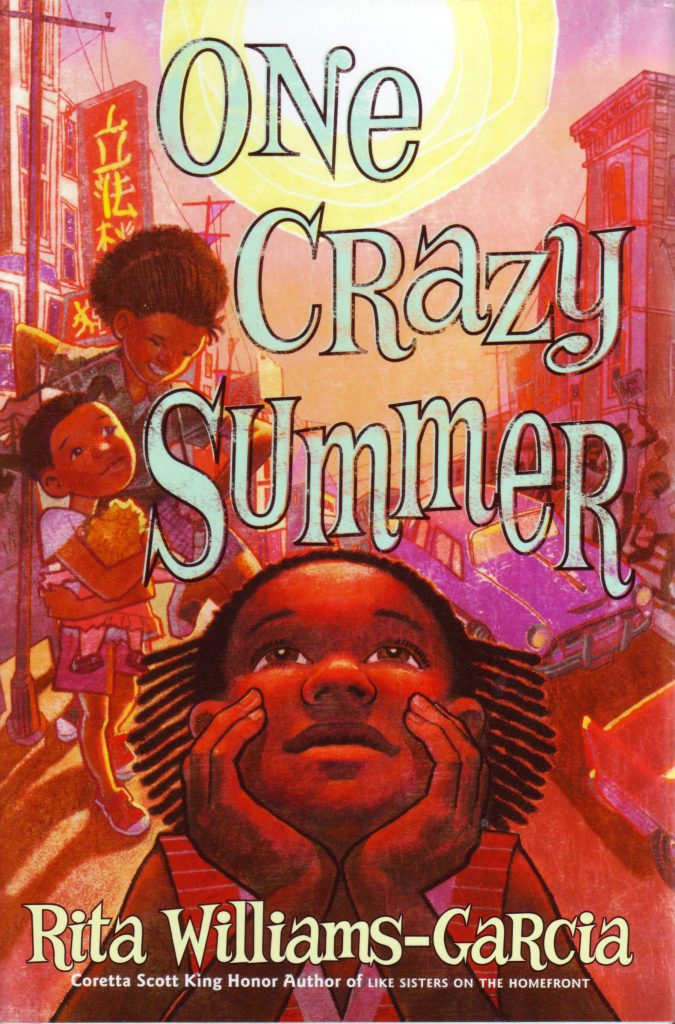
BIBLIOGRAPHY
Vawter, Vince. Paperboy. Read by Lincoln Hoppe. Portland, ME: Listening Library, 2013. Unabridged, 6 hr., 11 min.
PLOT SUMMARY
When he accidentally “busts” his friend, Rat, playing baseball, Vince agrees to take his friend’s paper route for the summer. There’s just one problem: Vince can hardly get a word out without stuttering up a storm, and he’s terrified of trying to talk to people he that don’t know about his condition. With lots of encouragement from Mam—his best friend and colored caretaker—and from his parents, Vince sets out on his month-long stint as paperboy. Vince’s route takes him to Mrs. Worthington, an attractive woman with sad eyes; Mr. Shapiro, an educated seaman and patient friend; TV Boy, a name that Vince makes up for a boy who always seems to be sitting in front of the television; and Ara T, an unkind junkman that Mam forbids Vince from talking to. Although Vince struggles to accept himself and to navigate the complex questions of life as he makes the transition from childhood to adolescence, his paper route provides Vince with life experiences that make Vince a better human being. By summer’s end, Vince has seen and experienced the effects of hate, sadness, and injustice, but he’s also learned where to go to give and receive kindness, love, and acceptance. The author’s note at the end of the story reveals the autobiographical nature of Paperboy and provides readers with deeper insights about stuttering.
CRITICAL ANALYSIS
Vince, or “Little Man” as Mam calls him, is a believable 11-year-old boy: He’s big into sports—baseball specifically—like many other boys his age; he has his first crush on his neighbor Mrs. Worthington; and he begins to see past the innocent lens of childhood into the harsh realities of his world. Why, for example, does Mam have to sit in the back of the bus? Why is Mrs. Worthington always drunk? Are Vince’s parents who he thinks they are? Why does Mam distrust the junkman Ara T? And why does Vince have a stutter? Readers will journey with Vince through one eventful summer and into young adulthood as Vince learns more about the world and his place within it.
Listening to the book in audio format was especially powerful. The narrator did an exceptional job of recreating the pausing, hissing stutters of Vince’s speech, giving readers a better understanding of Vince’s frustrations as he tries to get out the words he so desperately wants to say. The other characters—Mam, Mr. Spiro, Mrs. Worthington—were easily distinguishable due to the narrator’s skillful navigation of each character’s unique inflection, accent, and tone. The narration was engaging and easy to listen to, making it a great audiobook for long family car trips. And the final author’s note spoken by the protagonist himself is a special treat for invested listeners.
The story’s plot, however, may not catch many young readers’ attention. Although the story does include a man intent on committing a murder, most of the story is introspective and a little bit humdrum. Vince spends much of the text explaining the limitations he feels due to his stutter, the philosophical discussions he has with an educated neighbor, and the mundane daily happenings of the customers along his paper route. Adults may find this book a hard sell due to the book’s less than exciting plot, and young readers may not find it especially easy to connect with this slice-of-life memoir of the late 1950s.
Still, the themes of the story are timeless. While Vince begins the story trying to “fix” himself, he unashamedly accepts his limitations—stutter and all—by the book’s end. At the beginning of Paperboy, Vince tries to stay in the background, avoiding interaction rather than risk embarrassing himself and others. His experiences bringing paper—and his voice—to the doors of many houses helps him to stand tall and dare to be different. So while this book might require more coaxing than the standard middle-grade fare, its powerful message is one that many kids will take to heart.
AWARDS AND REVIEW EXCERPTS
Winner of the AudioFile Earphones Award, 2014
John Newbery Medal Honor Book, 2014
Washington Post Best Children’s Books, 2013
From AudioFile: “Lincoln Hoppe’s narration is pure perfection in this story about ‘Little Man,’ an 11-year-old boy with a stutter so severe that he can’t even say his own name. . . . Hoppe brings out Little Man’s endearing vulnerability and portrays the stutter with a tender ease and grace that will make listeners feel empathy and hope for the boy. . . . The afterword is read by author, and stutterer, Vince Vawter, making this an extraordinary listening and learning experience.”
From Kirkus: “Carefully crafted language, authenticity of setting and quirky characters that ring fully true all combine to make this a worthwhile read. Although Little Man’s stutter holds up dialogue, that annoyance also powerfully reflects its stultifying impact on his life. An engaging and heartfelt presentation that never whitewashes the difficult time and situation as Little Man comes of age.”
CONNECTIONS
- Discuss the significance of “TV Boy” in Vince’s story. How does Vince’s perception of the boy change over time? Invite students to get to know someone they may not know very well like Vince did, and teach middle schoolers the basics of American Sign Language.
- Read Paperboy and I Talk Like a River together. Discuss how the stutter affects each boy and how each one learns how to overcome his challenges.
- Scott, Jordan, and Sydney Smith (illustrator). I Talk Like a River. ISBN 9780823445592
- Vince is a skilled baseball player. Set out a sports display of other middle grade sports books such as the following:
- Rallison, Janette. Life, Love, and the Pursuit of Free Throws. ISBN 9780802788986
- Alexander, Lori, and Allan Drummond (illustrator). A Sporting Chance: How Paralympics Founder Ludwig Guttmann Saved Lives with Sports.ISBN 9781328580795
- Alexander, Kwame. Booked. ISBN 9780544570986
- Put out a display of all the 2014 Newbery Award finalists including Paperboy. Then allow middle-graders to vote on their favorite title and hold an awards ceremony for the favorite pick.
- DiCamillo, Kate, and K. G. Campbell (illustrator). Flora & Ulysses: The Illuminated Adventures. ISBN 9780763660406
- Black, Holly. Doll Bones. ISBN 9781416963981
- Henkes, Kevin. The Year of Billy Miller. ISBN 9780062268150
- Timberlake, Amy. One Came Home. ISBN 9780375869259
*Note—This book review was created as an assignment for a course at Texas Woman’s University.

